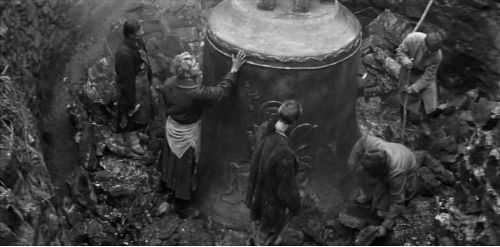Satyajit Ray*Bengali*110 minutes*
Ray is magical and this is a masterpiece. Only those who belong to the culture that he describes can appreciate it fully. Tarkovsky is right when he says that cultural divides can never be bridged. So is Roger Ebert when he says, the most specific is the most universal. Ray's language is so completely of his own time and place that it speaks to anyone anywhere.
He speaks of ordinary everyday things, but with sensitivity, understanding and sympathy; and an art so profound that again and again one experiences that lump in the throat, the sheer joy, nostalgia and delight to encountering something so perfect and natural and yet so familiar. Ray belongs to the world where touching the feet of elders as a mark of respect comes naturally. His inspiration never falters and the strokes pile one on another in its sheer flow of refined, gentle creativity, steering wide clear from excess or stereotypes.
The family has shifted to Varanasi after the village, Apu has grown an inch or so; they occupy a small portion in an old house, the father makes a living out of performing religious ceremonies, and the Ganges river laps the bathing ghats. The choice of Varanasi as a background is surely not arbitrary because this is a city vast in its historical and geographical embrace, and Apu is only a pretext for this cinematic epic in three parts. It is an ancient city, older than Rome or the pyramids, a place towards which the Buddha often turned in his wanderings. In the narrow alleys the cows mingle with the boys and the urchins, the dogs are thin and the monkeys gambol among the parapets.
Life is hard and the children play while the parents struggle and death claims her third as Hari succumbs even as Apu runs to fetch Ganges water for his dying father.
The people in the world of Ray's movies are more often good than bad, and sometimes they are really nice, as happens in real life too. Villainy, particularly of the distilled variety, is absent.
The steam engine with the widow and her inch-gaining son are tearing through the dusky plains towards yet another home in the countryside. Ray is too refined to directly inflict the bereavement process on us, for his narrative is swift as an arrow, even in the impression of languor that it conveys. The Varanasi segment of Aparajito is the one sequence that lingered and permeated in the crevices of my mind since I first saw it with it's heavy aromas of incense and cow dung. It is synecdochic. There must be a reason Varanasi-on-the-Ganges is known as the city of life and death and of eternity. The history of India is an inconspicuous actor in each film of Ray.
The portrayal of the mother Sarbajaya reminds me in its no-nonsense endurance, of all people, of the woman police officer in Fargo. We have a magnificent glimpse of a school in an Indian village, how a caring teacher encourages the impoverished boy, who is already earning something through his inherited knowledge of the priestly profession. The headmaster, the teacher and the inspector of schools are a beautiful vignette.
All of Ray's characters are people. We care for them. Ray pulls at our heartstrings. Ray is very much of the polyglottic hindi-bengali-english universe. Soon Apu, now a mid-adolescent is studying in a Calcutta college, while he works in a printing press, smokes and dreams of England and thinks ( maybe less than he should ) of his poor mother back home. We have a another wonderful glimpse of the educational system at the college level ( Calcutta was one of the intellectual capitals of India ) specially the cute and learned dhoti clad English professor who, to my surprise and delight, explains the meaning of the unfamiliar word synecdoche, fifty years before it became the title of another strange American film.
Then there is that unforgettable night amongst the glow-worms...
Ray is more often joyous than sad, but always heart-rending, for such is life.
It is a portrait of womanhood, in the role of mother. Ray, like Ingmar Bergman is a master of facial expression. Karuna Banerjee as Sarbajaya, Apu's mother with her dusky womanliness is the pivot of the first two parts of the trilogy. It is acting of extraordinary power equaling Maria Falconetti in The Passion of Joan of Arc.
Not quite half the marks must go to the music of Ravi Shankar, and his melodies which keep perfect step with the director--they are made for each other. Ravi Shankar is salt to Ray's rice.
Ray's cinema is a pure language of the heart.




